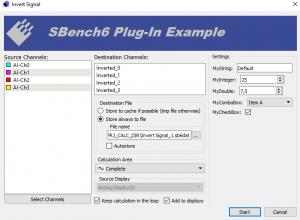 The plug-in interface is an optional SDK that allows the user to add their own advanced calculation functions to SBench 6. The SDK contains the interface and some examples that show how to program certain functionality. The self-compiled plug-in is then automatically linked into the SBench 6 calculation pool.
The plug-in interface is an optional SDK that allows the user to add their own advanced calculation functions to SBench 6. The SDK contains the interface and some examples that show how to program certain functionality. The self-compiled plug-in is then automatically linked into the SBench 6 calculation pool.
The SDK is based on C++. Any calculation that can be realized with standard development methods is possible. Programming custom calculation routines can turn SBench 6 software into a powerful application specific tool. Once the routines are developed the resulting plug-in files can then be freely distributed with any SBench 6 Professional license to other end-users. You don't need the SDK to run a previously programmed plug-in.
When using a Plug-in the resulting data files can be also displayed, used for further calculations, exported or can be made part of a report. For example, when using a digitizer together with sensors, the Plug-in could embed specific sensor calibration information into the program. The plug-in itself can be fed with one or more sets of acquired, or calculated, data from SBench 6.
Furthermore, when programming the plug-in the developer can define the necessary configurations for the interface. This can be: single integer or double values, combo boxes, strings or checkboxes. Any files in the system (such as, filter parameters, sensor calibration values or reference signals) can be utilized in the calculation.
The SDK also provides a call-back function for interaction with the user so that simple dialogs and other information, such as cautions or critical warnings, can then be flagged to the user.
The plug-in also allows to use an individual bitmap for graphic recognition.
A SBench 6 setup can look like this example:
- SB6: Load configuration of hardware
- SB6: Run an acquisition of 4 channels
- Plug-In 1 (Calibration): fed with data of the 4 channels: assign external sensor calibration values to the inputs, loaded from a file
- SB6: display original signals and calibrated signals in an analog display
- Plug-In 2 (Filter): fed with data of the 4 calibrated signals and some individual filter settings -> generates 4 new filtered signals
- SB6: display resulting signals of Plug-In 2
- SB6: run standard calculations on all signals
- SB6: generate a report using all acquired and generated signals and calculated figures
